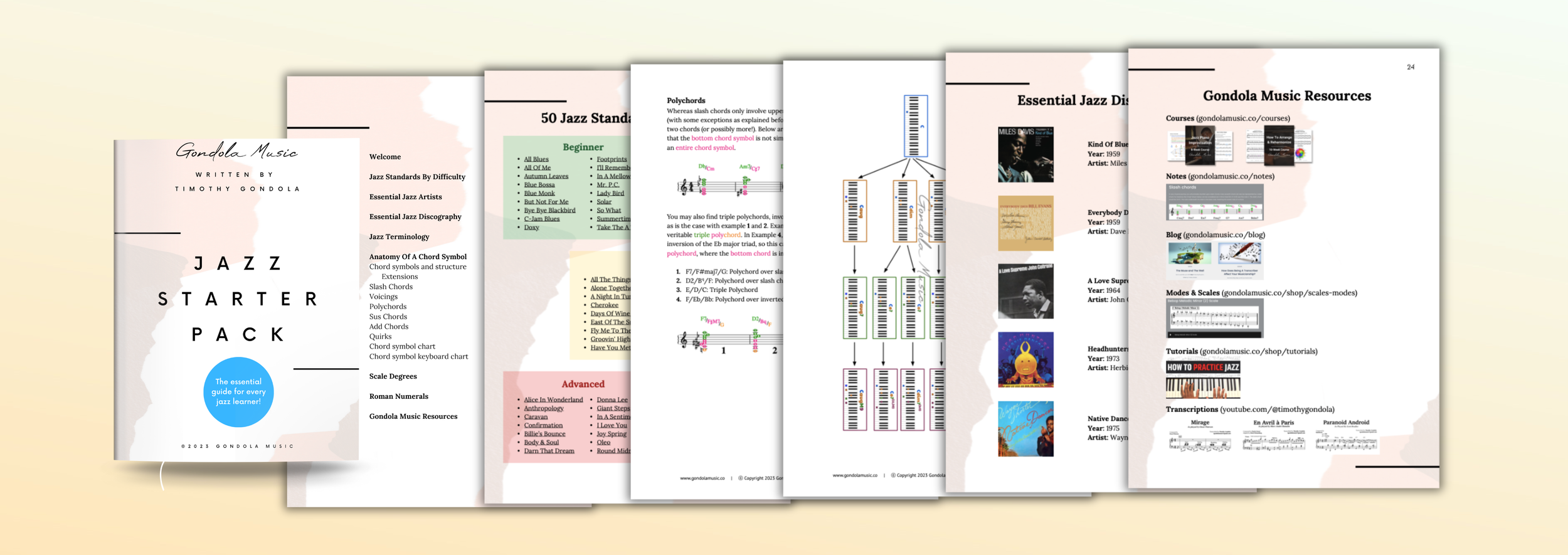Anatomy of a Chord Symbol
Chord Symbols
- The first letter in a chord symbol is always the key of the chord. This is also referred to as the tonic, the one, the home note, or scale degree one.
- The next figure in a chord symbol (M, m, dim, aug) refers to the quality of the triad– is it major, minor, diminished or augmented? “Triads” refer to three-note chords made up of the 1, 3 and 5 (scale degrees). When the letter is standalone, this refers to a major triad. So if you see C this means C major triad. A stands for A major triad.
- The 7 is the dominant 7, or flat seventh scale degree. Thus, the 7 in C7 is Bb. “Seventh chords” refers to four-note chords made up of the 1, 3, 5 and 7.
- Extensions are the 9th, 11th, and 13th scale degrees of a chord. These can either be natural (e.g. C9), sharp (e.g. F7#11) or flat (e.g. G7b13).
1) Lowercase m, min or - in a chord symbol all refer to minor.
Minor tends to sound more solemn, sad or angry.
2) Uppercase M, maj or Δ in a chord symbol all refer to major.
Major tends to sound more upbeat.
3) dim, o or º refer to diminished.
Diminished tends to sound sad and lamenting.
4) aug or + refer to augmented.
Augmented tends to sound spooky and jarring.
Knowing scale degrees is critical to understanding chord symbols; to learn more about scale degrees [click here]. The 5 (dominant), and extensions can be either flat, natural (unchanged), or sharp. An 11th can only be sharp and not flat, since it would just become the 3 (mediant).
The 7 is actually a half-step down from normal. So when we’re referring to chord tone 7 in the key of C, we’re actually referring to B♭, the dominant/minor 7, rather than B. The 7th is the only interval or chord tone that deviates from the scale degrees.
For simplicity’s sake, I’ve used the key of C for all chord examples and diagrams, but remember that a chord symbol can be in any key (Am7, Dmaj9, F#-11b9). In each of these three examples I just gave, the 1 is the first note of that chord (A, D, F# respectively).
♭5 and # 5:
The 5 can be flatted or sharped. If the 5 becomes sharp (G natural to G sharp in the key of C), the chord is called augmented. This is a peculiar harmony which can sound somewhat spooky. Fun fact: an augmented triad is two major thirds built upon each other. When the 5 is flatted (G natural to G flat in the key of C), we don’t have a name for that harmony, the same way we call the sharp 5 augmented. However, if you flat the 5 and the 3 (G to Gb and E to Eb in the key of C) your new harmony is called diminished.
Common chords with b5: Cm7(b5),
Common chords with #5: Cmaj7(#11,#5)
M7:
Because the 7 is the only chord tone which is flat (minor), it can become major (from Bb to B in the key of C).
♭9 and # 9:
Flat and sharp 9 add spice to your regular dominant seven chord. They don’t work too well with major seven chords and minor seven chords (#9 [D#] is redundant in a minor seven chord, as it is equivalent to the flat 3 [Eb]).
Common chords with b9: C13(b9),
Common chords with #9: C7(#11,b9)
# 11: Sharp 11 can also be interpreted as II/I, or D/C. Where D’s 3 (F#) is C’s #11.
Common chords with #11: C7(#11,b9)
♭13: The flat 13 adds a fantastic touch to your dominant seven chord.
Common chords with b13: C7(b13,#9)
Note: An extension chord can imply the extensions beneath it. So if you see C13, you can throw in the 9 and 11 as well, even though they’re not explicitly written. Inversely, if you see a standard seventh chord symbol (e.g. Bm7, EbΔ7) it’s up to your creative imagination to spice that chord up with extensions, even though they’re not marked.
Enjoying the view? Download to review this Note Offline.
Slash chords
In your musical journey you will probably stumble upon slash chords. Every seventh chord can also be represented by a slash chord. For instance, the Cmaj7 drawn below can be considered an E minor triad (Em: E-G-B) over the note C. This slash chord would be: Em/C. The note underneath the slash is the bass note, meaning the lowest note of a chord.
Note: 7th chords are not usually written as slash chords, these were just used to demonstrate the concept.
Just like a regular chord symbol can be played in many configurations, so can the top chord of a slash chord. Here you see how the Gmaj7 chord symbol is reconfigured in three forms, the first being the straightforward one.
You can also use slash chord symbols to represent chord inversions.
Citations:
LaVerne, A. (2015). Quick Chords. United States: Jamey Aebersold Jazz.








